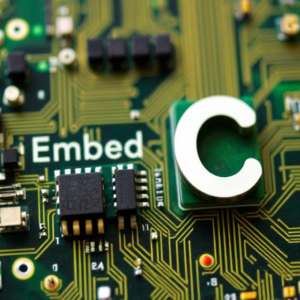What is Embedded C?
Embedded C is a special version of the C programming language designed for programming microcontrollers. Microcontrollers are small computers found in many electronic devices like microwaves, washing machines, cars, and even toys. They are responsible for controlling the operations of these devices.

What is a Microcontroller?
A microcontroller is a small chip that acts like the brain of an electronic device. It has a processor, memory (RAM and ROM), and input/output (I/O) pins. The processor performs tasks based on instructions from the program, the memory stores data, and the I/O pins connect to sensors or other devices.
Why use C for Microcontrollers?
C is popular for embedded systems because it gives you control over hardware (like how to access the memory or control the pins) while still being relatively easy to understand and write. It also allows you to write efficient and fast programs, which is important for embedded systems where resources (like memory and processing power) are limited.
Basic Components of Embedded C Programming:
- Microcontroller Hardware:
- This includes the microcontroller chip itself and any other connected hardware (like LEDs, motors, buttons, etc.).
- Programming Language (C):
- The program is written in C language to control the microcontroller’s hardware.
- Embedded Development Environment:
- A toolset that helps you write, compile, and upload the code to the microcontroller. Examples include Arduino IDE, Keil, or Atmel Studio.
- Compiler:
- The compiler converts your C code into machine code that the microcontroller can understand.
- Program Code:
- The C program is written using basic programming concepts like variables, functions, loops, conditionals, and so on.
Key Concepts in Embedded C for Microcontrollers:
- Registers:
- Microcontrollers have special memory locations called registers that control various hardware features. These registers are used to configure the microcontroller and interface with sensors, motors, etc.
- GPIO (General Purpose Input/Output):
- Microcontrollers have pins that can be set as inputs (to read data like a button press) or outputs (to send data like turning on an LED). In Embedded C, you control these pins using registers.
- Interrupts:
- Interrupts are used to handle events that happen unexpectedly, like a button press or a sensor reading. The microcontroller stops what it’s doing and responds immediately.
- Timers:
- Microcontrollers have timers that help you measure time intervals or create delays. For example, a timer could blink an LED every second.
- Analog to Digital Conversion (ADC):
- Many microcontrollers can read analog signals (like the output from a temperature sensor) and convert them to digital values that the program can understand.
Basic Structure of an Embedded C Program:
An embedded C program generally has a simple structure, consisting of:
- Initialization (Setup):
- This is where you set up the microcontroller’s registers, configure the I/O pins, and prepare any peripherals (like ADC, timers, etc.).
- Main Program (Loop):
- After the setup, the program enters the main loop. In embedded systems, this loop runs continuously, handling tasks like checking button presses, reading sensors, or controlling actuators (like turning on an LED).
- Functions and Libraries:
- You can write custom functions to organize your code better. You can also use libraries to interact with specific hardware components (e.g., a motor driver or an LCD screen).
Example of Simple Embedded C Program:
Here’s a simple example of turning an LED on and off using an embedded C program:
#include <avr/io.h> // Include the AVR microcontroller library
int main() {
// Set pin 0 of PORTB as output
DDRB = 0x01; // Data Direction Register B (DDRB)
while (1) {
// Turn LED on
PORTB = 0x01; // PORTB controls the state of the pins
// Wait for some time (delay)
_delay_ms(1000); // This is a built-in delay function
// Turn LED off
PORTB = 0x00;
// Wait again
_delay_ms(1000);
}
return 0; // End of program (won't actually reach here)
}
In this example:
DDRB = 0x01;configures pin 0 of PORTB as an output.- The
PORTB = 0x01;turns the LED on, andPORTB = 0x00;turns it off. _delay_ms(1000);introduces a 1-second delay between the on and off states of the LED.
Key Considerations in Embedded C Programming:
- Resource Constraints:
- Microcontrollers have limited memory (RAM and flash memory). So, you need to write efficient code that uses minimal memory.
- Real-Time Operation:
- Many embedded systems need to respond to events immediately, so you often write code to run in real-time.
- Low-Level Programming:
- You often work with hardware directly (e.g., writing to registers, configuring pins). This is different from high-level programming where the underlying hardware is abstracted away.
- Debugging:
- Debugging embedded C code can be tricky since you often don’t have the same debugging tools available as in desktop programming. You may need to use tools like oscilloscopes or serial monitors to check what’s happening with your program.
Conclusion:
Embedded C Programming for microcontrollers allows you to control and interact with hardware. It combines the power of the C language with direct control over the microcontroller’s hardware features. By writing programs in Embedded C, you can make everything from simple gadgets to complex systems work efficiently, responding to sensors and controlling outputs.
Tags: _delay_ms, actuator control, ADC (Analog to Digital Conversion), Arduino IDE, Atmel Studio, AVR microcontroller, C language, C libraries, code efficiency, code optimization, compiler, custom functions, data direction register., DDRB, Debugging tools, delay functions, development tools, digital I/O, direct register access, electronics control, electronics projects., embedded applications, Embedded C, Embedded C Programming, embedded code structure, embedded development environment, embedded software development, Embedded Systems, firmware development, functions, GPIO, hardware control, initialization, input/output pins, interrupts, Keil, LED control, Libraries, low-level programming, machine code, main loop, Memory, Microcontroller, Microcontroller Applications, microcontroller features, microcontroller programming, oscilloscope, pin configuration, port configuration, PORTB, processor, programming language, RAM, real-time programming, real-time systems, registers, resource constraints, ROM, sensor interfacing, serial monitor, structured code, Timers


